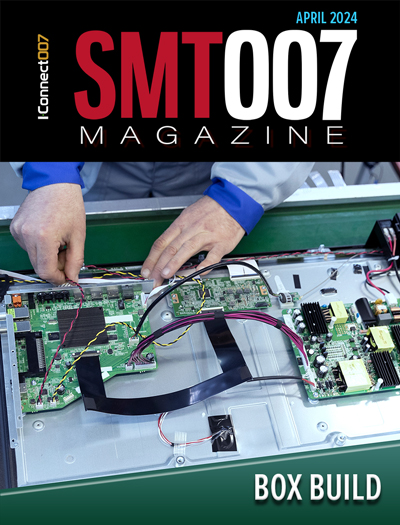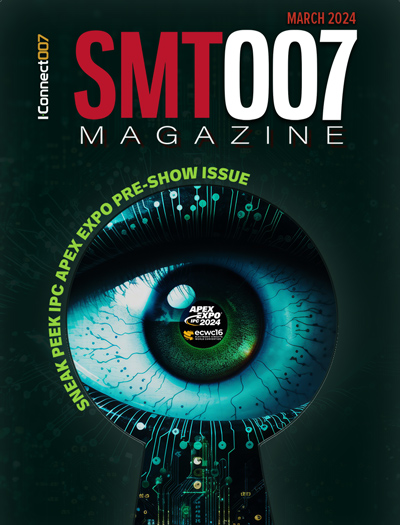-

- News
- Books
Featured Books
- smt007 Magazine
Latest Issues
Current Issue
Box Build
One trend is to add box build and final assembly to your product offering. In this issue, we explore the opportunities and risks of adding system assembly to your service portfolio.

IPC APEX EXPO 2024 Pre-show
This month’s issue devotes its pages to a comprehensive preview of the IPC APEX EXPO 2024 event. Whether your role is technical or business, if you're new-to-the-industry or seasoned veteran, you'll find value throughout this program.

Boost Your Sales
Every part of your business can be evaluated as a process, including your sales funnel. Optimizing your selling process requires a coordinated effort between marketing and sales. In this issue, industry experts in marketing and sales offer their best advice on how to boost your sales efforts.
- Articles
- Columns
Search Console
- Links
- Events
||| MENU - smt007 Magazine
The Effectiveness of 75% IPA/25% DI Extraction Solution on No-clean Flux Residues
June 13, 2019 | David Lober and Mike Bixenman, DBA, KYZEN; and Marietta Lemieux and Mark McMeen, STIEstimated reading time: 12 minutes
The continuous challenge in the electronics industry is to keep up with the demand for smaller, faster, and more reliable electronics. This places great strains on the manufacturers of those electronics. The strain on manufacturing electronics comes from every direction. Environmental regulations have removed lead from the majority of electronics, forcing materials changes. Packages have become smaller with more voltage requirements. Complex devices are expected to work reliably for years under harsh environments that would be unimaginable to a circuit designer one decade ago. These examples and many more combine to create a multitude of challenges.
This rapid development of manufacturing and reliability challenges is juxtaposed with the slow pace of new test method development. Resistance of Solvent Extract (ROSE) testing is the de facto ionic contamination testing method primarily because it was developed in 1970, when PCBs were becoming more common in military and other high-reliability applications. In the ROSE method, a PCB to be tested is submerged in a solution of 75% isopropanol or IPA (but more properly propan-2-ol) and 25% DI water. The change in the resistance of the solution is monitored. As ionic materials dissolve into solution, the resistance of the solution decreases, indicating that there is ionic contamination.
This dip in resistance is then converted into the mass of sodium chloride per unit area that would be expected to produce an equivalent dip in the resistance of the solution. Traditionally, this is expressed as micrograms of sodium chloride equivalent per square centimeter (μg NaCl eq. /cm2). Shortly after ROSE’s development, the United States Department of Defense decided that a value of 1.56 μg NaCl eq. /cm2 was to be used as a criterion for product acceptance. If a particular assembly was below this value, it would be acceptable for field use.
Relevant to the current work is the decision to use the extraction solution of 75%/25% IPA/DI water. This decision was made because the vast majority of solder fluxes on the market were rosin based, and therefore, highly soluble in IPA. This is because the major constituent of rosin is abietic acid and is highly soluble in IPA [1]. The true systematic name for abietic acid is abieta-7,13-dien-18-oic acid (CAS Number 514-10-3) and is shown in Figure 1 [2]. It is commonly cited as virtually insoluble in water, but it does exhibit some solubility in water [3]. It is also known to be highly soluble in various organic solvents, although exact numbers are hard to come by [2, 4, & 5].
Once dissolved into solution, abietic acid can ionize into an electrically conductive species that can be measured by resistance. This is what characterizes abietic acid as what our industry calls weak organic acids (WOAs). The degree to which the ionization occurs is highly dependent on pH, but will cause a change in resistance none the less.
Figure 1: Abietic acid structure [1].
As time progressed, newer fluxes entered the market that were not based on rosin, namely water soluble (WS), or sometimes called “water wash flux,” and no-clean (NC), or “low-residue flux.” There is a multitude of reasons why these fluxes came onto the market and why they necessitated different WOAs, but those are beyond the scope of this article. The flux manufacturers turned toward a different type of organic acid, linear dicarboxylic acids. Dicarboxylic acids are organic molecules that have two carboxylic acid groups, and linear dicarboxylic acids are simply the dicarboxylic acid derivatives of straight chain hydrocarbons.
The exact identities of the dicarboxylic acids used are considered proprietary, but there are a series of dicarboxylic acids that have been reported in the literature, such as adipic acid, succinic acid, glutaric acid, malic acid [6,7], and more recently, pimelic acid [8]. Table 1 shows the structure of these acids [9]. The important thing to note from the structures in Table 1 is that they are substantially different from that of abietic acid, and as a result, they all have some degree of solubility in water.
Table 1: Common dicarboxylic acids.
One additional consideration is that the WOAs can react. One known chemical reaction that they undergo is acid-base reactions. In this reaction, WOAs react with a base, such as an amine activator, metals, or other bases that are present. These result in the formation of a salt. Typically, organic salts are more soluble in water than organic solvents; this property is a common way to purify WOAs [10]. It is suspected by the authors that these WOA salts are capable of causing current leakage paths or even ECM. When dissolved, these salts result in the formation of an electrolyte solution.
During this time, a new cleanliness assessment method was introduced to the industry in the form of ion chromatography (IC). IC is an analytical technique from the liquid chromatography family and can be used to identify and quantify ionic species in solution. A small portion of a liquid sample (typical volume ~25 μL) is injected into a moving fluid called an eluent. The eluent carries the sample to an analytical column. This column consists of very fine particles coated with an ionic compound. This coating attracts the ions of interest, slowing them down. The degree of this slowing depends on a number of factors, but the ultimate goal is to slow each ion of interest down enough that they travel as discrete bands in the plumbing of the instrument. This causes the ions to be removed by the eluent from the column at different times.
Page 1 of 3
Suggested Items
AIM to Highlight NC259FPA Ultrafine No Clean Solder Paste at SMTA Wisconsin Expo & Tech Forum
04/18/2024 | AIMAIM Solder, a leading global manufacturer of solder assembly materials for the electronics industry, is pleased to announce its participation in the upcoming SMTA Wisconsin Expo & Tech Forum taking place on May 7 at the Four Points by Sheraton | Milwaukee Airport, in Milwaukee, Wisconsin.
Hentec/RPS Publishes an Essential Guide to Selective Soldering Processing Tech Paper
04/17/2024 | Hentec Industries/RPS AutomationHentec Industries/RPS Automation, a leading manufacturer of selective soldering, lead tinning and solderability test equipment, announces that it has published a technical paper describing the critical process parameters that need to be optimized to ensure optimal results and guarantee the utmost in end-product quality.
Empowering Electronics Assembly: Introducing ALPHA Innolot MXE Alloy
04/16/2024 | MacDermid Alpha Electronics SolutionsIn the rapidly evolving electronics industry, where innovation drives progress, MacDermid Alpha Electronics Solutions is committed to setting a new standard. Today, we are pleased to introduce ALPHA Innolot MXE, a revolutionary alloy meticulously engineered to address the critical needs of enhanced reliability and performance in modern electronic assemblies.
New Book on Low-temperature Soldering Now Available
04/17/2024 | I-Connect007I-Connect007 is pleased to announce that The Printed Circuit Assembler’s Guide to… Low-temperature Soldering, Vol. 2, by subject matter experts at MacDermid Alpha Electronics Solutions, is now available for download.
Inkjet Solder Mask ‘Has Arrived’
04/10/2024 | Pete Starkey, I-Connect007I was delighted to be invited to attend an interactive webinar entitled “Solder Mask Coating Made Easy with Additive Manufacturing,” hosted by SUSS MicroTec Netherlands in Eindhoven. The webinar was introduced and moderated by André Bodegom, managing director at Adeon Technologies, and the speakers were Mariana Van Dam, senior product manager PCB imaging solutions at AGFA in Belgium; Ashley Steers, sales manager at Electra Polymers in the UK; and Dr. Luca Gautero, product manager at SUSS MicroTec Netherlands.


